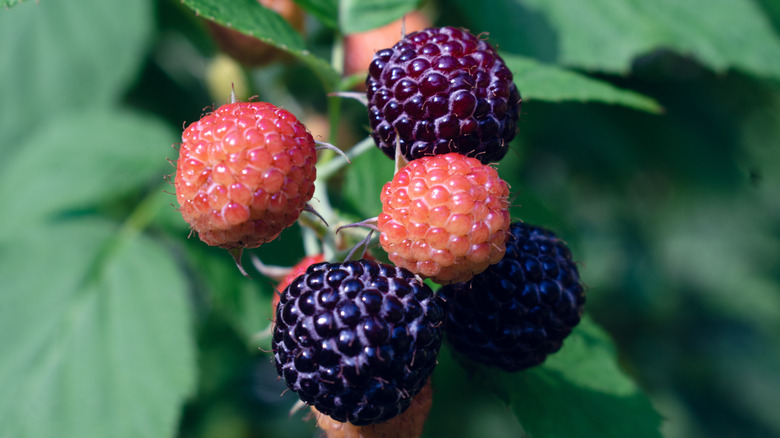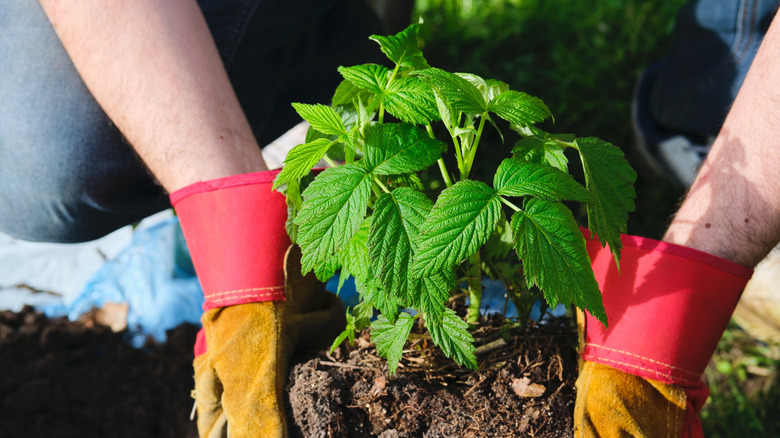Why You Shouldn't Grow Black Raspberries And Red Raspberries In The Same Patch
After you've enjoyed your first juicy raspberry harvest, you may be tempted to plant another bush — the more delicious berries, the better. But raspberries come in several different types, and it's best not to grow them in the same patch or you risk spreading damaging and incurable diseases.
Raspberries are categorized by the color of their fruits: red, black, purple, and yellow. Each tastes slightly different, but they're all tasty and nutritious, serving as a good source of vitamins A and C as well as antioxidants and minerals. Red and black are the most common types of raspberry; purple raspberries are hybrids of the two. It's understandable to want a couple different types on hand to add more variety and interest to your yard (and kitchen).
However, growing red raspberries in the same patch as black raspberries is a bad idea. Those in the red category can carry several dangerous diseases without showing any symptoms. They can then spread these diseases to black raspberries, which are much more vulnerable and may suffer permanent damage. The same vulnerability affects purple raspberries.
Why red raspberries are risky for others
Raspberries in general are susceptible to a range of viruses and often need to be replaced eventually as a result. The most common and damaging is the raspberry mosaic disease complex, which consists of several viruses that cause a mosaic-like mottling effect in the leaves. Viruses in this disease complex include black raspberry necrosis virus, raspberry leaf mottle virus, raspberry leaf spot virus, and rubus yellow net virus. You can't tell exactly which virus is involved without testing, and it's often multiple at once.
Red raspberries can be infected by raspberry mosaic disease without showing any symptoms. Black and purple raspberries, however, are more vulnerable, and that's why it's important to keep them apart from each other. No treatments exist to kill mosaic viruses. Once a plant is infected with one, it's sure to kill your raspberries. Symptoms include light green mottling in the leaves, puckering, stunted growth, and crumbly fruit. Eventually, the canes will die back and stop producing. To make matters worse, raspberry mosaic disease is transmitted by aphids, which are impossible to fully control.
Outside of raspberry mosaic disease, many other viruses as well as fungal diseases can infect the plant. Some are spread by pollen, seeds, or soil rather than aphids. And just like raspberry mosaic disease, a few more of these viruses and fungal diseases are asymptomatic in red raspberries but dangerous in black or purple raspberries, such as orange rust.
How to play it safe
Separate red raspberries from black or purple raspberries with as much distance as your garden allows. Additionally, plant black or purple raspberries upwind from red raspberries so that any virus-carrying aphids are less likely to blow their way. If you haven't planted any raspberries at all yet, look for varieties that are disease-resistant due to being resistant to aphids, such as Canby, Titan, or Royalty. It's also important to shop for disease-free stock in general.
Other precautions are also useful in preventing raspberry infection. Avoid planting raspberries and blackberries together, as blackberries can carry curl virus — another common virus that also affects raspberries — without any symptoms. Avoid planting raspberries near any wild brambles, including both raspberries and blackberries. Lastly, when possible, avoid planting raspberries where others have grown previously, as some diseases can spread through soil.
As long as you take these precautions into account before you plant a raspberry bush, raspberries are a rewarding and easy plant to grow. They thrive in containers as well as raised beds; they require soil that's well-draining, on the sandy loam side, and rich in organic matter. They start producing in as little as one or two years, and they will continue producing for many years to come if kept disease-free.


